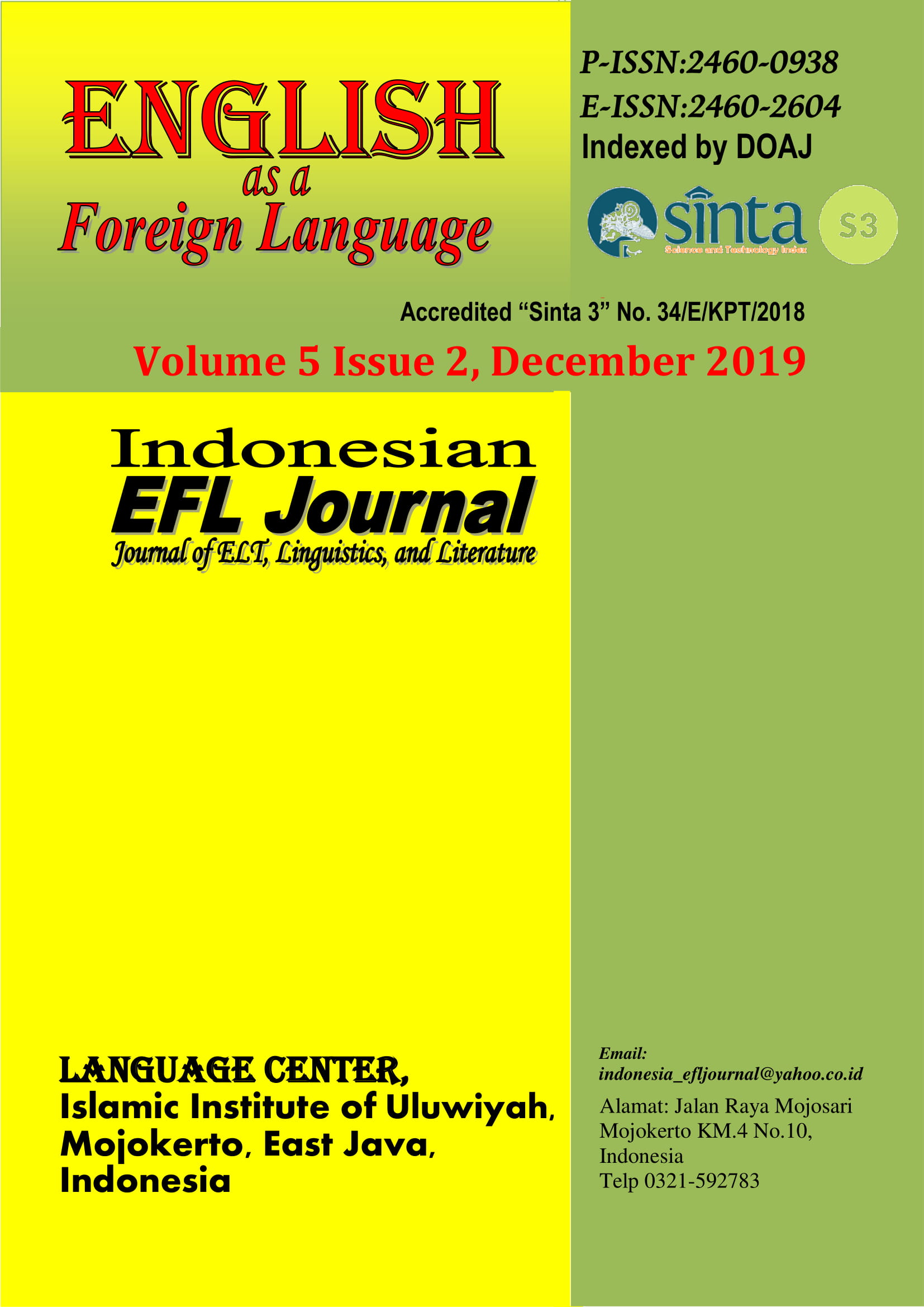Error Analysis and Its Implications for the English Classroom: A Case Study of an Advanced English Learner
Abstract
This study aims to examine English spoken language uttered by Indonesian EFL learners by employing error and interlanguage analysis. It principally focuses on highlighting the value of error and interlanguage analysis on the development of Indonesian English language teaching classroom. The data were in the form of language transcription taken from a structured sociolinguistics interview with an advanced English learner. The results indicate that errors, either on phonological, grammatical, lexical, or pragmatic competence, are principally caused by L1 or interlingual transfer, despite few occurrences of developmental errors. Regarding the implication of this study for language classroom, it offers several suggestions for improving English language classroom including an introduction of varieties of chunk languages and adjacency pairs used across cultures to students.
References
Brown, P., & Levinson, S. C. (1978). Universals in language usage: Politeness phenomena. In E. N. Goody (Ed.), Questions and Politeness: Strategies in Social Interaction (pp. 56–289). Cambridge: Cambridge University Press.
Carter, R., & Mncarthy, M. (1995). Grammar and the Spoken Language. Applied Linguistics, 16(2), 141–158. https://doi.org/10.1093/applin/16.2.141
Choroleeva, K. (2009). Language transfer: Types of linguistic errors committed by francophones learning English as a second foreign language. Humanising Language Teaching Magazine, 11(5), 110–123.
Connor, U. (1996). Contrastive Rhetoric: Crosscultural Aspects of Second Language Writing. Cambridge: Cambridge Univeristy Press.
Corder, S. P. (1981). Error Analysis and Interlanguage. Oxford: Oxford University Press.
Culpeper, J., Haugh, M., & Kádár, D. Z. (2017). Introduction. In J. Culpeper, M. Haugh, & D. Z. Kádár (Eds.), The Palgrave Handbook of Linguistic (Im)politeness (pp. 1–8). London: Palgrave Macmillan.
Davies, C. E., & Tyler, A. E. (2005). Discourse strategies in the context of crosscultural institutional talk: Uncovering interlanguage pragmatics in the university classroom. In K. Bardovi-Harlig & B. S. Hartford (Eds.), Interlanguage Pragmatics: Exploring Institutional Talk (pp. 133–156). New Jersey: Lawrence Erlbaum Associates.
Ellis, R. (1985a). Sources of variability in interlanguage. Applied Linguistics, 6(2), 118–131. https://doi.org/10.1093/applin/6.2.118
Ellis, R. (1985b). Understanding Second Language Acquisition. Oxford: Oxford University Press.
Ellis, R. (2003). Task-Based Language Learning and Teaching. Oxford: Oxford University Press.
Ellis, R. (2008). The Study of Second Language Acquisition (2nd ed.). Oxford: Oxford University Press.
Ellis, R., & Barkhuizen, G. (2005). Analysing Learner Language. Oxford.
Fauziati, E. (2017). Native and target language influence on the students’ interlanguage production: A case of indonesian EFL compositions. Indonesian Journal of Applied Linguistics, 7(1), 54–63. https://doi.org/10.17509/ijal.v7i1.6858
Feagin, C. (2002). Entering the community: Fieldwork. In J. K. Chamber, P. Trudgill, & N. Schilling-Estes (Eds.), The Handbook of Language Variation and Change (pp. 20–39). Oxford: Blackwell.
Gass, S. M., & Selinker, L. (2008). Second language acquisition : an introductory course (3rd ed.). London: Routledge.
Johnson, K. (2013). An Introduction to Foreign Language Learning and Teaching. Routledge.
Jones, C., & Waller, D. (2015). Corpus Linguistics for Grammar: A guide for Research. London: Routledge.
Lightbown, P. M., & Spada, N. (2013). How Languages are Learned (4th ed.). Oxford: Oxford University Press.
Mitchell, R., & Myles, F. (2004). Second Language Learning Theories (2th ed.). London: Hodder Arnold.
Mora, J. C., & Levkina, M. (2017). Task-based pronunciation teaching and research: Key issues and future directions. Studies in Second Language Acquisition, 39(2), 381–399. https://doi.org/10.1017/S0272263117000183
O’Grady, W., Archibald, J., & Katamba, F. (2011). Contemporary Linguistics: An Introduction (2nd ed.). Harlow: Longman.
O’Keeffe, A. (2011). Introducing pragmatics in use (B. Clancy & S. Adolphs, eds.). Abingdon: Routledge.
Polat, B., & Kim, Y. (2014). Dynamics of Complexity and Accuracy: A Longitudinal Case Study of Advanced Untutored Development. Applied Linguistics, 35(2), 184–207. https://doi.org/10.1093/applin/amt013
Poulisse, N., & Bongaerts, T. (1994). First language use in second language production. Applied Linguistics, 15(1), 36–57. https://doi.org/10.1093/applin/15.1.36
Pudin, C. S. J., Storey, J. M., Len, L. Y., Swanto, S., & Din, W. A. (2015). Exploring L1 interference in the writings of Kadazandusun ESL students. Indonesian Journal of Applied Linguistics, 5(1), 54–62. https://doi.org/10.17509/ijal.v5i1.831
Richards, J. C. (1971). A non-contrastive approach to error analysis. ELT Journal, XXV(3), 204–219. https://doi.org/10.1093/elt/XXV.3.204
Sharwood-Smith, M. (1994). Second Language Learning. New York: Longman.
Solano, P. A. C., Torres, P. F. G., Cueva, C. A. O., Beltran, A. L. Q., Cuesta, L. M. C., Jaramillo, L. M. S., … Cordova, M. O. A. (2014). Spanish interference in EFL writing skills: A Case of Ecuadorian Senior High Schools. English Language Teaching, 7(7), 40–48. https://doi.org/10.5539/elt.v7n7p40
Swan, M., & Smith, B. (2001). Learner English: A Teacher’s Guide to Interference and Other Problems (2nd ed.). Cambridge: Cambridge University Press.
Tarone, E., & Swierzbin, B. (2009). Exploring Leaner Language. Oxford: Oxford Univeristy Press.
Thomas, J. (1995). Meaning in interaction : an introduction to pragmatics. London; New York: Longman.
Thornburry, S. (2005). Beyond the Sentence: Introducing Discourse Analysis. Oxford: Macmillan Education.
Watcharapunyawong, S., & Usaha, S. (2013). Thai efl students’ writing errors in different text types: The interference of the first language. English Language Teaching, 6(1), 67–78. https://doi.org/10.5539/elt.v6n1p67
Williams, J. (2005). Writing center interaction: Institutional discourse and the role of peer tutors. In K. Bardovi-Harlig & B. S. Hartford (Eds.), Interlanguage Pragmatics: Exploring Institutional Talk (pp. 133–156). New Jersey: Lawrence Erlbaum Associates.
Young, J. Y. (2001). Malay/Indonesian speakers. In M. Swan & B. Smith (Eds.), Learner English: A teacher’s guide to interference and other problems (pp. 279–295). Cambridge: Cambridge University Press.
Yule, G. (1996). Pragmatics. Oxford: Oxford University Press.
Copyright (c) 2020 Indonesian EFL Journal: Journal of ELT, Linguistics, and Literature

This work is licensed under a Creative Commons Attribution-ShareAlike 4.0 International License.
All rights reserved.
this publication may be reproduced, stored in a retrieval system, or transmitted
in any form or by any means, electronic, mechanical, photocopying, recording.




